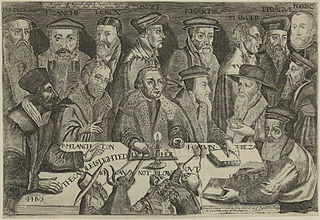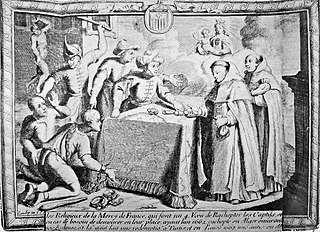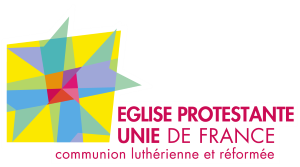
Calvinism is a major branch of Protestantism that follows the theological tradition and forms of Christian practice set down by John Calvin and other Reformation-era theologians.

The Reformation was a movement within Western Christianity in 16th-century Europe that posed a religious and political challenge to the Roman Catholic Church – and papal authority in particular. Although the Reformation is usually considered to have started with the publication of the Ninety-five Theses by Martin Luther in 1517, there was no schism between the Catholics and the nascent Lutheran branch until the 1521 Edict of Worms. The edict condemned Luther and officially banned citizens of the Holy Roman Empire from defending or propagating his ideas. The end of the Reformation era is disputed: it could be considered to end with the enactment of the confessions of faith which began the Age of Orthodoxy. Other suggested ending years relate to the Counter-Reformation, the Peace of Westphalia, or that it never ended since there are still Protestants today.

A patron saint, patroness saint, patron hallow or heavenly protector is a saint who in Roman Catholicism, Anglicanism or Eastern Orthodoxy, is regarded as the heavenly advocate of a nation, place, craft, activity, class, clan, family or person.

A Continental Reformed church is a Reformed church that has its origin in the European continent. Prominent subgroups are the Dutch Reformed, the Swiss Reformed, the French Reformed (Huguenots), the Hungarian Reformed, and the Waldensian Church in Italy.

Hieromartyr Cyril Lucaris or Loukaris, born Constantine Lucaris, was a Greek prelate and theologian, and a native of Candia, Crete. He later became the Greek Patriarch of Alexandria as Cyril III and Ecumenical Patriarch of Constantinople as Cyril I. He is alleged by Calvinists, both of his time and modern, to have strove for a reform of the Eastern Orthodox Church along Protestant and Calvinist lines. Attempts to bring Calvinism into the Orthodox Church were rejected, and Cyril's actions, motivations, and specific viewpoints remain a matter of debate among scholars. However, he is recognized by the Orthodox Church as a hieromartyr and defender of the Orthodox faith against both the Jesuit Catholics and Calvinist Protestants. The official glorification of Hieromartyr Cyril Loukaris took place by decision of the Holy Synod of the Patriarchate of Alexandria on October 6, 2009, and his memory is commemorated on June 27.

The Schmalkaldic League was a military alliance of Lutheran princes within the Holy Roman Empire during the mid-16th century. Although originally started for religious motives soon after the start of the Reformation, its members later came to have the intention that the League would replace the Holy Roman Empire as their focus of political allegiance. While it was not the first alliance of its kind, unlike previous formations, such as the League of Torgau, the Schmalkaldic League had a substantial military to defend its political and religious interests. It received its name from the town of Schmalkalden, which is located in modern Thuringia.

The Peace of Augsburg, also called the Augsburg Settlement, was a treaty between Charles V, Holy Roman Emperor, and the Schmalkaldic League, signed in September 1555 at the imperial city of Augsburg. It officially ended the religious struggle between the two groups and made the legal division of Christianity permanent within the Holy Roman Empire, allowing rulers to choose either Lutheranism or Roman Catholicism as the official confession of their state. However, the Peace of Augsburg arrangement is also credited to ending much Christian unity around Europe. Before, the main religion was Roman Catholicism with a few practicers of Lutheranism. Now, if a ruler chose for his or her subjects to practice Lutheranism, the population which endorsed and practiced Lutheranism increased greatly. Calvinism was not allowed until the Peace of Westphalia.

Cuius regio, eius religio is a Latin phrase which literally means 'whose realm, his religion', meaning that the religion of the ruler was to dictate the religion of those ruled. This legal principle was a major development in the collective if not individual freedom of religion in Western civilization.

The Synod of Jerusalem was convened by Orthodox Patriarch Dositheos Notaras in March 1672. Because the occasion was the consecration of the Church of the Nativity in Bethlehem, it is also called the Synod of Bethlehem.
The term "Evangelical Catholic" is used by Christians who consider themselves both "catholic" and "evangelical".

Christianity is the predominant religion in Austria. At the 2001 census, 73.6% of the country's population was Catholic. As of 2018, the number of Catholics has dropped to 56.9% of the population, according to data provided by the Austrian Catholic Church itself. There is a much smaller group of Evangelicals, totalling about 4.7% of the population in 2001, shrunk to 3.3% in 2018. Since 2001, these two historically dominant religious groups in Austria recorded losses in the number of adherents. The Catholic Church reported an absolute drop of 15.7%, the Evangelical Lutheran and Evangelical Reformed churches of 1.3%. In relative numbers the losses of the smaller Evangelical churches account for 33.7%, compared to Catholic losses which account for 21.9%, since their maximum in 1971.
The Uppsala Synod in 1593 was the most important synod of the Lutheran Church of Sweden. Sweden had gone through its Protestant Reformation and broken with Roman Catholicism in the 1520s, but an official confession of faith had never been declared.
The Three Forms of Unity is a collective name for the Belgic Confession, the Canons of Dort, and the Heidelberg Catechism, which reflect the doctrinal concerns of continental Calvinism and are accepted as official statements of doctrine by many of the Reformed churches.

Calvinism originated with the Reformation in Switzerland when Huldrych Zwingli began preaching what would become the first form of the Reformed doctrine in Zürich in 1519.

The Protestant Theological Institute is a Protestant seminary and private university in Cluj-Napoca, Romania. The state-recognized institution trains ministers for four separate Protestant denominations: Calvinism, Lutheranism, and Unitarianism.

Protestantism is the second largest form of Christianity with collectively between 800 million and more than 900 million adherents worldwide or nearly 40% of all Christians. It originated with the 16th century Reformation, a movement against what its followers perceived to be errors in the Roman Catholic Church. Protestants reject the Roman Catholic doctrine of papal supremacy and sacraments, but disagree among themselves regarding the real presence of Christ in the Eucharist. They emphasize the priesthood of all believers, justification by faith alone rather than by good works, and the highest authority of the Bible alone in faith and morals. The "five solae" summarise basic theological differences in opposition to the Roman Catholic Church.

Anglo-Turkish piracy or the Anglo-Barbary piracy refers to the collaboration between Barbary pirates and English pirates against Catholic shipping during the 17th century.

The United Protestant Church of France is the main and largest Protestant church in France, created in 2013 through the unification of the Reformed Church of France and the Evangelical Lutheran Church of France.

















